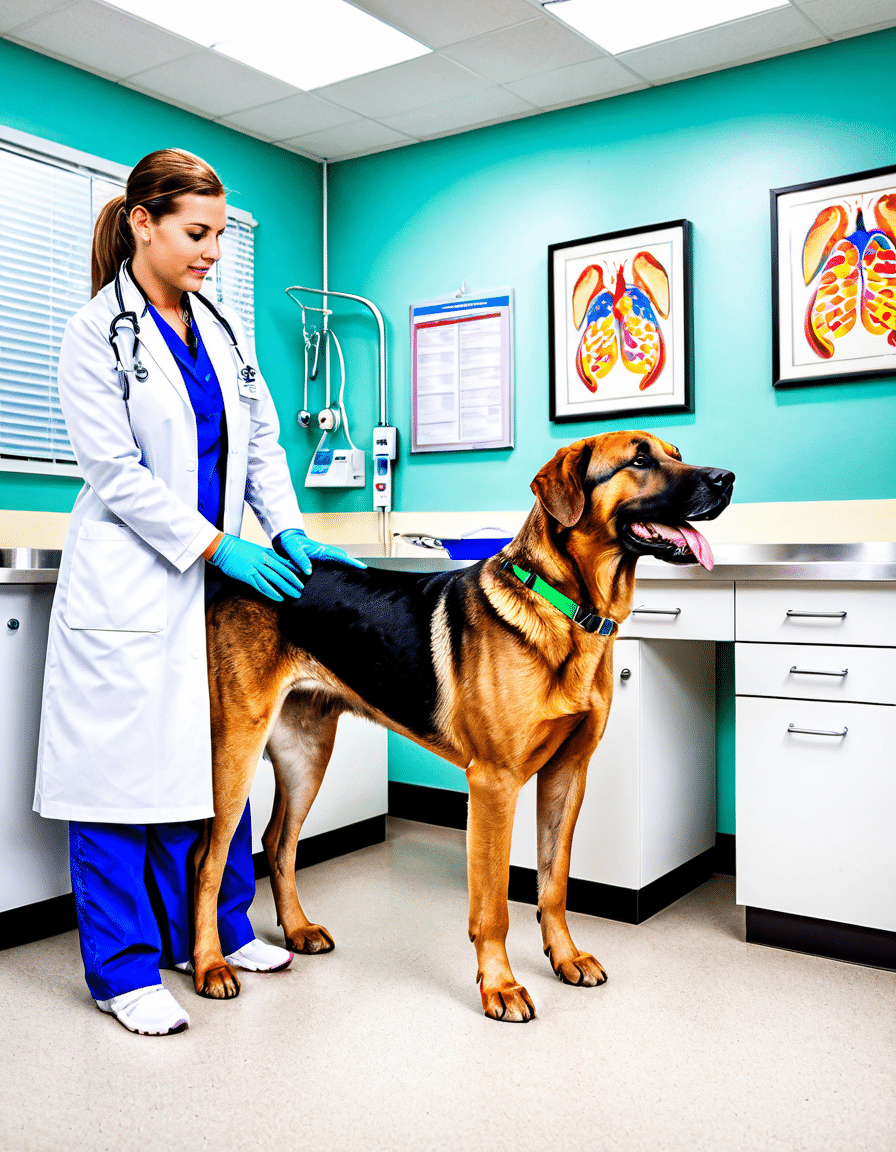Subcutis edema is a condition characterized by the accumulation of fluid beneath the skin, often leading to significant swelling and discomfort in pets. This fluid build-up can occur in a variety of animals, including dogs and exotic pets like the Scleropages formosus (Asian Arowana). Uncovering the nuances of subcutis edema is essential for pet owners, as it can indicate underlying health issues that require prompt veterinary attention.
Recognizing the symptoms of subcutis edema is the first step in ensuring your pet receives the care they need. Swelling, discomfort, altered behavior, and changes in appetite can all be tell-tale signs that something’s not right. Immediate veterinary evaluation can make a world of difference, allowing for timely diagnosis and treatment.
1. What is Subcutis Edema?
Subcutis edema occurs when excess fluid collects in the subcutaneous tissue, leading to localized swelling. It can be caused by various factors and may appear in several areas of your pet’s body. This condition is not exclusive to any one species; dogs, cats, rabbits, and even exotic pets can develop subcutis edema, making awareness critical among all pet owners.
For our furry friends, the swelling can cause considerable discomfort, and it often indicates a more significant underlying problem that may need addressing. Conditions causing subcutis edema can range from allergic reactions to infections and even chronic diseases. Therefore, understanding the causes and treatment options is vital for any responsible pet parent.

2. Top 5 Causes of Subcutis Edema in Pets
Understanding the potential causes of subcutis edema is essential for diagnosis and treatment. Here are the five primary causes to take into account:
2.1 Allergic Reactions
Allergic reactions are one of the leading culprits behind subcutis edema. When pets are exposed to certain allergens such as specific foods, insect stings, or harmful topical medications, their immune system can overreact, causing inflammation and fluid build-up. A classic example is a dog suffering from discoid lupus erythematosus experiencing a sudden allergic reaction to another medication, leading to noticeable swellings.
2.2 Infections
Infections—whether bacterial or viral—can also lead to subcutis edema. For example, dogs can develop lymphangitis, an infection that affects the lymphatic vessels and subsequently causes fluid accumulation. When dealing with infections, prompt veterinary intervention is key, and your veterinarian may recommend antibiotics for treatment to combat the swelling.
2.3 Vasculitis
Vasculitis refers to inflammation of the blood vessels, which can cause fluid to seep into the surrounding tissues. This condition is usually secondary to other medical issues, such as autoimmune diseases, and may show symptoms like redness and heat in the affected area. If your pet seems off and you notice these signs, it’s essential to seek veterinary care quickly.
2.4 Trauma
Subcutis edema can also occur due to trauma. If your dog got a little too rough while playing or had a mishap, the resulting tissue damage can cause localized swelling. It’s a natural response as the body works to heal itself, but it might also require veterinary attention, especially if the swelling does not subside or worsens.
2.5 Systemic Diseases
Systemic diseases like heart disease or renal dysfunction can lead to generalized subcutis edema. In cases such as myasthenia gravis, dogs may present with swelling due to their weakened muscles and issues with fluid regulation in the body. Regular vet check-ups can help catch these chronic issues early, preventing complications.
3. Treatment Options for Subcutis Edema in Dogs and Exotic Pets
Treating subcutis edema is a multi-faceted approach that focuses on addressing the underlying cause while managing symptoms. Here are some treatment options you can discuss with your vet:
3.1 Medications
Medications play a significant role in managing subcutis edema. Corticosteroids can effectively reduce inflammation, while antihistamines may be helpful if allergies are the source of the swelling. In instances of anxiety related to discomfort, veterinarians might consider prescribing trazodone OD, which can help keep your pet calm during recovery.
3.2 Dietary Adjustments
For pets experiencing edema from allergies, a shift to hypoallergenic diets can make all the difference. Brands like Hill’s Prescription Diet and Royal Canin offer specialized options tailored for pets with food sensitivities. Discussing dietary changes with your vet can help ease symptoms and reduce the chances of future incidents.
3.3 Surgical Intervention
In severe cases, surgical procedures might be necessary to remove the source of infection or relieve persistent fluid accumulation. This is especially pertinent when addressing issues caused by chronic trauma or the presence of foreign objects embedded in the tissues. Early surgical intervention may speed up healing and prevent further complications.
3.4 Supportive Care
Supportive care goes a long way. Ensuring pets get plenty of rest, proper hydration, and compression bandaging can help minimize swelling and promote healing. For exotic pets like the Osteoglossum bicirrhosum (Asian Arowana), a stress-minimized environment can significantly improve recovery prospects.
3.5 Specialized Therapies
Innovative therapies like manual lymphatic drainage are emerging as effective treatments for chronic edema. These therapies can improve circulation and reduce swelling in pets dealing with long-term issues. Consult with a veterinary professional who offers specialized services for additional treatment options.

4. Case Study: Subcutis Edema in a Scleropages Formosus
An enlightening case showcases the management of subcutis edema in the exotic Scleropages formosus (Asian Arowana). One particular fish presented with swelling due to poor water quality and a secondary bacterial infection. Treatment included enhancing the water conditions, administering specific antibiotics, and employing stress-reduction techniques in their habitat to foster a more stable environment. This case underscores the importance of maintaining optimal living conditions for exotic pets to prevent health concerns.
5. Recognizing the Signs: When to Seek Help
Being aware of the signs is crucial. Look for localized swelling, discomfort, altered behavior, or decreased appetite in your pet. Immediate veterinary evaluation is advised if pets display these symptoms, especially if they coincide with severe signs of illness, such as vomiting or lethargy.
Ultimately, the presence of subcutis edema signifies that your pet may have a variety of underlying health issues, from simple allergies to more serious systemic diseases. Early identification and intervention significantly increase the chances of effective treatment and recovery, allowing your beloved pet to regain their quality of life.
Subcutis edema may sound alarming, but with the right knowledge and proactive approach, pet owners can make informed decisions that lead to excellent outcomes for their furry, scaly, or feathery companions! If you want to stay informed about pet health topics, consider exploring other articles, like those on treatments for rabies in cats or lighthearted reads such as the gag cat meme. Always keep an eye on your pet’s health, paired with the expert advice of your veterinarian!
Understanding Subcutis Edema: Fun Facts and Trivia
What is Subcutis Edema?
Did you know that subcutis edema can occur not just in pets, but in humans too? This condition refers to the swelling beneath the skin due to fluid accumulation, which can be caused by varying factors like allergies, infections, or even heart issues. It might sound scary, but just like the plot twists in Fight Night: The Million Dollar Heist Episodes, the causes behind this condition can often be surprising and multifaceted! Pet owners should keep an eye out for changes in skin texture, as this could indicate underlying health issues.
Causes and Connections
Interestingly, this kind of edema can also be linked to bite wounds or infections, which raises the importance of understanding how to manage these complications. For example, did you know that rabies can lead to severe health issues in cats, making the treatment approach crucial? You can learn more about this in our article on rabies in Cats treatment. It’s fascinating how many aspects of animal health interconnect, not unlike the plot developments found in Hell’s Paradise Season 2. Additionally, an unexpected fact: chicken physiology is quite different from that of mammals, which leads many to ponder, Does a chicken pee? Well, those curious about how animals function can discover just how complex their systems really are!
Treatment Options
As for treatment, there are some remarkable therapies like compression bandaging used to reduce swelling. Speaking of unique approaches, like big iron figurative meanings in tales of struggle and triumph, specific treatments for subcutis edema can serve as a metaphor for overcoming challenges in pet care. Maintaining a strong relationship with your veterinarian is essential, just as ensuring your own doggo is a muscular doggo can mean a healthy lifestyle for them! Each case presents its own set of challenges, but with informed decisions, pet owners can navigate these waters smoothly.
So, whether you’re navigating treatment options or just pondering the quirks of pet anatomy, doing your homework can uncover fascinating facts and tips to help your furry friends thrive. And who knows? You might stumble upon interesting connections, like the whimsical fashion of moon boots women blending style with comfort while you care for your pet’s health!






